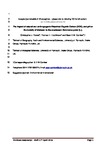The impact of natural and anthropogenic Dissolved Organic Carbon (DOC), and pH on the toxicity of triclosan to the crustacean Gammarus pulex (L.).
| dc.contributor.author | Comber, Sean | |
| dc.contributor.author | Rowett, C | |
| dc.contributor.author | Hutchinson, Tom | |
| dc.date.accessioned | 2017-01-26T09:44:13Z | |
| dc.date.issued | 2016-09-15 | |
| dc.identifier.issn | 0048-9697 | |
| dc.identifier.issn | 1879-1026 | |
| dc.identifier.uri | http://hdl.handle.net/10026.1/8314 | |
| dc.description.abstract |
Regulatory ecotoxicology testing rarely accounts for the influence of natural water chemistry on the bioavailability and toxicity of a chemical. Therefore, this study identifies whether key omissions in relation to Dissolved Organic Carbon (DOC) and pH have an impact on measured effect concentrations (EC). Laboratory ecotoxicology tests were undertaken for the widely used antimicrobial compound triclosan, using adult Gammarus pulex (L.), a wild-type amphipod using synthetic fresh water, humic acid solutions and wastewater treatment works effluent. The toxicity of triclosan was tested at two different pHs of 7.3 and 8.4, with and without the addition of DOC and 24 and 48hour EC values with calculated 95% confidence intervals calculated. Toxicity tests undertaken at a pH above triclosan's pKa and in the presents of humic acid and effluent, containing 11 and 16mgL(-1) mean DOC concentrations respectively, resulted in significantly decreased triclosan toxicity. This was most likely a result of varying triclosan speciation and complexation due to triclosan's pKa and high hydrophobicity controlling its bioavailability. The mean 48hour EC50 values varied between 0.75±0.45 and 1.93±0.12mgL(-1) depending on conditions. These results suggest that standard ecotoxicology tests can cause inaccurate estimations of triclosan's bioavailability and subsequent toxicity in natural aquatic environments. These results highlight the need for further consideration regarding the role that water chemistry has on the toxicity of organic contaminants and how ambient environmental conditions are incorporated into the standard setting and consenting processes in the future. | |
| dc.format.extent | 222-231 | |
| dc.format.medium | Print-Electronic | |
| dc.language | en | |
| dc.language.iso | en | |
| dc.publisher | Elsevier | |
| dc.relation.replaces | 10026.1/5181 | |
| dc.relation.replaces | http://hdl.handle.net/10026.1/5181 | |
| dc.subject | Triclosan | |
| dc.subject | Effluent | |
| dc.subject | pH | |
| dc.subject | TOXICITY | |
| dc.subject | bioavailability | |
| dc.subject | Dissolved Organic Carbon | |
| dc.title | The impact of natural and anthropogenic Dissolved Organic Carbon (DOC), and pH on the toxicity of triclosan to the crustacean Gammarus pulex (L.). | |
| dc.type | journal-article | |
| dc.type | Journal Article | |
| plymouth.author-url | https://www.webofscience.com/api/gateway?GWVersion=2&SrcApp=PARTNER_APP&SrcAuth=LinksAMR&KeyUT=WOS:000378206300020&DestLinkType=FullRecord&DestApp=ALL_WOS&UsrCustomerID=11bb513d99f797142bcfeffcc58ea008 | |
| plymouth.volume | 565 | |
| plymouth.publication-status | Published | |
| plymouth.journal | Science of the Total Environment | |
| dc.identifier.doi | 10.1016/j.scitotenv.2016.04.170 | |
| pubs.merge-from | 10026.1/5181 | |
| pubs.merge-from | http://hdl.handle.net/10026.1/5181 | |
| plymouth.organisational-group | /Plymouth | |
| plymouth.organisational-group | /Plymouth/Faculty of Science and Engineering | |
| plymouth.organisational-group | /Plymouth/Faculty of Science and Engineering/School of Geography, Earth and Environmental Sciences | |
| plymouth.organisational-group | /Plymouth/REF 2021 Researchers by UoA | |
| plymouth.organisational-group | /Plymouth/REF 2021 Researchers by UoA/UoA06 Agriculture, Veterinary and Food Science | |
| plymouth.organisational-group | /Plymouth/Research Groups | |
| plymouth.organisational-group | /Plymouth/Research Groups/BEACh | |
| plymouth.organisational-group | /Plymouth/Research Groups/Marine Institute | |
| plymouth.organisational-group | /Plymouth/Users by role | |
| plymouth.organisational-group | /Plymouth/Users by role/Academics | |
| dc.publisher.place | Netherlands | |
| dcterms.dateAccepted | 2016-04-24 | |
| dc.rights.embargodate | 2017-5-9 | |
| dc.identifier.eissn | 1879-1026 | |
| dc.rights.embargoperiod | 12 months | |
| rioxxterms.versionofrecord | 10.1016/j.scitotenv.2016.04.170 | |
| rioxxterms.licenseref.uri | http://www.rioxx.net/licenses/under-embargo-all-rights-reserved | |
| rioxxterms.licenseref.startdate | 2016-09-15 | |
| rioxxterms.type | Journal Article/Review |


